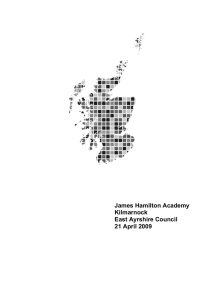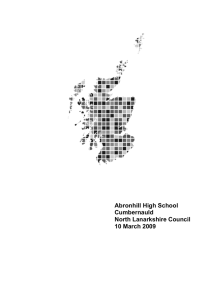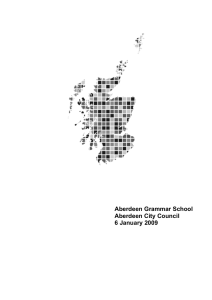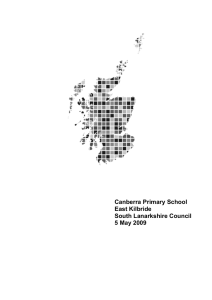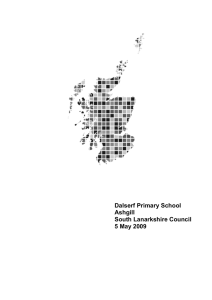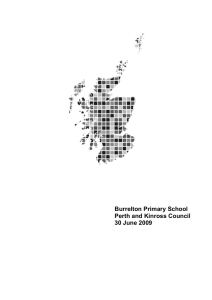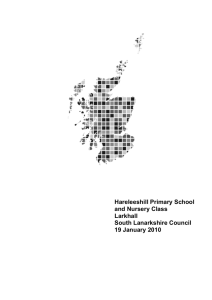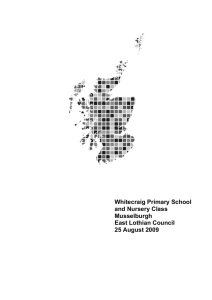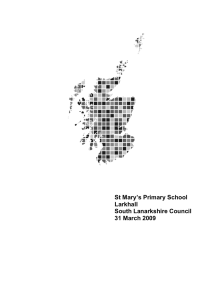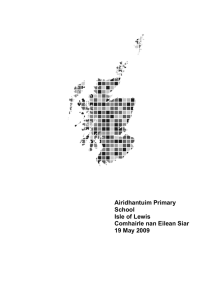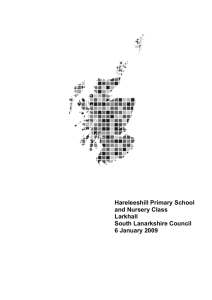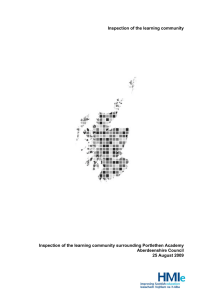Portlethen Academy Aberdeenshire Council 1 September 2009
advertisement
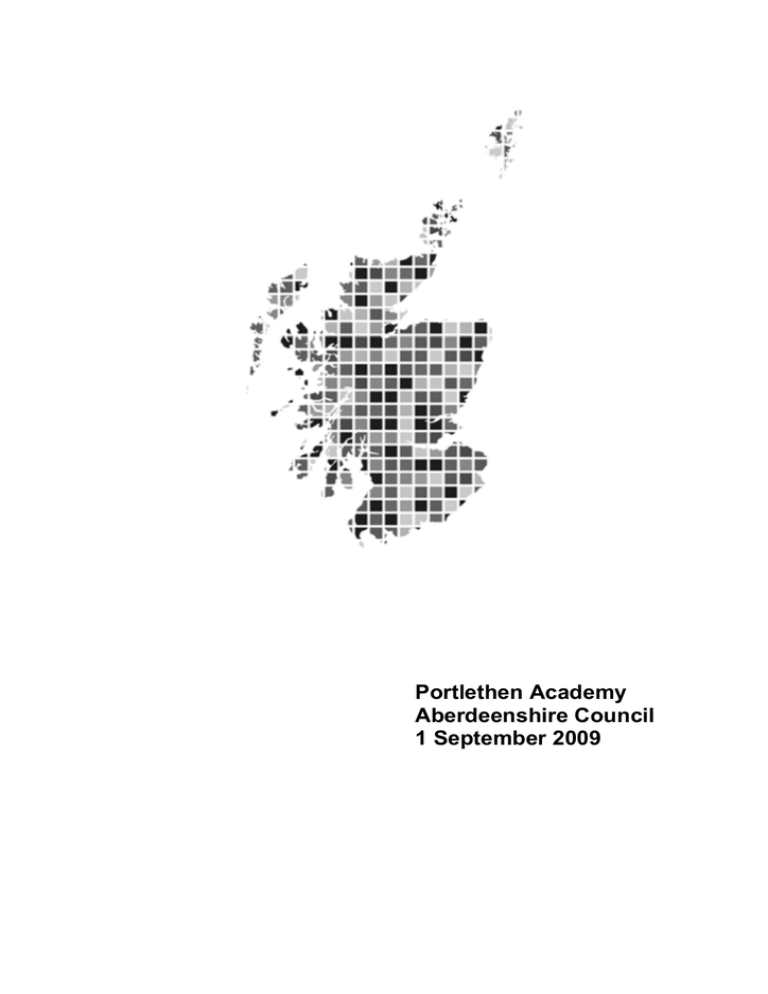
Portlethen Academy Aberdeenshire Council 1 September 2009 This report tells you about the quality of education at the school. We describe how children and young people benefit from learning there. We explain how well they are doing and how good the school is at helping them to learn. Then we look at the ways in which the school does this. We describe how well the school works with other groups in the community, including parents1 and services which support children and young people. We also comment on how well staff, children and young people work together and how they go about improving the school. Our report also describes the ‘ethos’ of the school. By ‘ethos’ we mean the relationships in the school, how well children and young people are cared for and treated and how much is expected of them in all aspects of school life. Finally, we comment on the school’s aims. In particular, we focus on how well the aims help staff to deliver high quality learning, and the impact of leadership on the school’s success in achieving these aims. If you would like to learn more about our inspection of the school, please visit www.hmie.gov.uk. Here you can find analyses of questionnaire returns and details about young people’s examination performance. Where applicable, you will also be able to find descriptions of good practice in the school and a report on the learning community surrounding the school. 1 Throughout this report, the term ‘parents’ should be taken to include foster carers, residential care staff and carers who are relatives or friends. Contents 1. The school 2. Particular strength of the school 3. Examples of good practice 4. How well do children and young people learn and achieve? 5. How well do staff work with others to support the learning of children and young people? 6. Are staff, children and young people actively involved in improving their school community? 7. Does the school have high expectations of all children and young people? 8. Does the school have a clear sense of direction? 9. What happens next? 1. The school Portlethen Academy is a non-denominational school. It serves Portlethen and the surrounding area south of Aberdeen. The roll was 804 when the inspection was carried out in June 2009. Young people’s attendance was above the national average in 2007/2008. 1 2. Particular strengths of the school • Support for young people with additional needs. • Courteous, confident and self-assured young people who have very positive relationships with almost all staff. • Innovative developments in the curriculum which are broadening the range and quality of young people’s experiences. • Contribution of community learning and development partners, including the community schools network, to young people’s wider achievements, health and wellbeing. • The quality of young people’s experiences and their achievement in some areas of their learning, both in and out of school. • Commitment of a considerable number of staff to developing and sharing best practice to improve learners’ experiences. 3. Examples of good practice • Threads in the Tartan – an innovative learning experience. • The international and global citizenship programme. 4. How well do children and young people learn and achieve? Learning and achievement Young people benefit from a range of high-quality learning experiences, both in and out of school. They really enjoy learning 2 where the work is well planned, challenging and relevant. They respond very well to tasks which involve them in making choices and decisions, especially as part of a group. In these tasks, young people take on responsibility for their own learning very effectively. They support and develop well the learning of others by sharing their own knowledge. Across the school, young people feel safe and secure and have positive relationships with almost all staff. They understand how to stay healthy. For many, positive experiences have led to more interest in learning and improved attendance. However, in some subjects and classes young people do not find the learning approaches sufficiently varied or interesting, which results in them making slow progress in those classes. Young people have no systematic way of giving their views on what they think about their learning experiences. Young people achieve very highly across a wide range of stimulating and imaginative out-of-class activities, which develop their confidence and leadership abilities. All young people in S1 and S2 have achieved Dynamic Youth Awards for fundraising work in support of charities. Each year a notable number at S4 and S5 gain Youth Achievement Awards. Those young people who take part in the Prince’s Trust XL achieve Award Scheme and Accreditation Network (ASDAN) awards at bronze and silver level. The high-quality work of young people in areas such as developing awareness of global citizenship is also recognised through ASDAN awards. The confidence of young people in the XL club has increased through leading talks and tours for the Anne Frank exhibition currently on display in the library. Across the school, young people develop and exercise a range of skills through the school’s enterprising approach to many activities, such as running the school radio station. In S1/S2, most young people achieve appropriate standards in reading and mathematics, and the majority do so in listening, talking and writing. Attainment in mathematics and writing is improving. Most young people are progressing well in their other subjects. From S4 to S6, young people’s attainment has been consistently around or above national averages. Young people with additional support needs make 3 very good progress in their learning. Overall, results for young people at S4 are better than in schools which serve young people with similar needs and backgrounds, but results at S5/S6 are notably poorer than in those schools. At S5, girls have been achieving lower results than boys in the last few years. Higher than average numbers of young people leave to go to further education or employment after S4, or to higher education after S5/S6. In most years hardly any young people leave school without going on to continue their education, or to enter training or employment. Curriculum and meeting learning needs Senior managers have developed a curriculum which helps young people to be effective learners both in and out of school. They use flexible and creative approaches very well to take account of young people’s changing and emerging needs. Improvements have been in line with Curriculum for Excellence. Literacy and health and wellbeing, for example, have been embedded very well across young people’s learning experiences. Young people benefit from two hours of highquality physical education each week. Staff have introduced very wellplanned projects such as Environmental Awareness which link learning across several subject areas. Young people benefit from opportunities to learn outdoors and beyond school, through such activities as fieldwork, educational trips, work experience and outdoor education. All young people are able to have a residential experience, and most choose to take up this opportunity. The school provides a broad and balanced range of courses and programmes. Innovative programmes, such as The Maersk Stars and Threads in the Tartan, broaden and enrich young people’s learning experiences. Links with community partners and Aberdeen College provide high quality opportunities for vocational education. The school is building on its strong pastoral links with associated primary schools to improve curricular links for example in the development of literacy skills. Most teachers set well-chosen tasks for young people. Many of the activities are imaginative and challenging and engage young people well. However, this is not consistent enough. In a few lessons, the 4 pace is slow, explanations are not clear, and young people do not get the help they need. The school meets the learning needs of the wide range of young people who need additional support very well. Staff are skilful at identifying and understanding those needs, and sharing key information. They work very effectively with a range of agencies to deliver varied and interesting learning experiences which support young people very well in preparing for their future lives. 5. How well do staff work with others to support the learning of children and young people? Partner organisations involved in the community schools network are working very well together to extend and enhance learning opportunities. The school has valuable links with Aberdeen College and Aberdeen University to support the range of courses it can offer, and facilities such as laboratories to support the teaching of science. Links with businesses, particularly the Maersk oil company, are long-standing and effective. Parents, including the Parent Council, support the school by attending events and organising fundraising. Overall, they value the quality of achievement and learning that the school provides. However, they are not yet fully involved in commenting on and supporting young people’s learning. School staff deal effectively with any complaints. The very high-quality school building houses the community library and facilities for community learning and development staff. This aids joint working with agencies, partner organisations and local businesses, and assists library staff in bringing about a positive impact on young people’s learning. The building has been specifically designed to support young people with particular needs or disabilities. 6. Are staff, children and young people actively involved in improving their school community? The pupil forums and other groups are improving many aspects of the school community such as through work for charities. The eco group has effectively raised awareness of environmental issues. Young people in S4 have successfully given presentations on internet safety 5 to younger pupils. Senior managers and principal teachers observe lessons to identify effective practice and areas for improvement. Many staff are working hard to develop their teaching approaches and to share good practice and ideas. This has resulted in a number of more positive learning experiences for young people. There remains scope for all staff to address the inconsistent quality of teaching and learning across the school. 7. Does the school have high expectations of all children and young people? Almost all staff have high expectations for young people’s behaviour, attitude and achievements. They celebrate young people’s successes very well. Almost all young people have high expectations for themselves and are committed to the school. They have a clear understanding of worldwide issues relating to religious and cultural diversity and sustainability, and healthy lifestyles. 8. Does the school have a clear sense of direction? The headteacher, senior managers and most staff share a clear and strong vision for the school. This vision is to provide young people with the widest possible range of high quality learning experiences. They have been largely successful in implementing this vision. The headteacher and senior managers support staff well, and have been instrumental in establishing a climate which encourages good practice and innovation. The headteacher should now give a strong lead in ensuring that senior managers and principal teachers address weaknesses in young people’s learning and attainment. 9. What happens next? As a result of the good quality of education provided by the school, we will make no further visits following this inspection. The education authority will inform parents about the school’s progress as part of the authority’s arrangements for reporting to parents on the quality of its schools. 6 We have agreed the following areas for improvement with the school and education authority. • Improve approaches to evaluating the school’s work so that they take account of young people’s views and lead to improvements in the quality and consistency of young people’s learning experiences. • Improve attainment at S5/S6. Quality indicators help schools and nursery classes, education authorities and inspectors to judge what is good and what needs to be improved in the work of a school and a nursery class. You can find these quality indicators in the HMIE publications How good is our school? and The Child at the Centre. Following the inspection of each school, the Scottish Government gathers evaluations of three important quality indicators to keep track of how well all Scottish schools and nursery classes are doing. Here are the evaluations for Portlethen Academy. Improvements in performance Learners’ experiences Meeting learning needs good good good We also evaluated the following aspects of the work of the school. The curriculum Improvement through self-evaluation Managing Inspector: Brian Stewart 7 very good satisfactory 1 September 2009 To find out more about inspections or get an electronic copy of this report go to www.hmie.gov.uk. Please contact the Business Management and Communications Team (BMCT) if you wish to enquire about our arrangements for translated or other appropriate versions. If you wish to comment about any of our inspections, contact us at HMIEenquiries@hmie.gsi.gov.uk or alternatively you should write in the first instance to BMCT, HM Inspectorate of Education, Denholm House, Almondvale Business Park, Almondvale Way, Livingston EH54 6GA. Our complaints procedure is available from our website www.hmie.gov.uk or alternatively you can write to our Complaints Manager, at the address above or by telephoning 01506 600259. If you are not satisfied with the action we have taken at the end of our complaints procedure, you can raise your complaint with the Scottish Public Services Ombudsman (SPSO). The SPSO is fully independent and has powers to investigate complaints about Government departments and agencies. You should write to SPSO, Freepost EH641, Edinburgh EH3 0BR. You can also telephone 0800 377 7330, fax 0800 377 7331 or e-mail: ask@spso.org.uk. More information about the Ombudsman’s office can be obtained from the website at www.spso.org.uk. This report uses the following word scale to make clear judgements made by inspectors. excellent very good good satisfactory weak unsatisfactory outstanding, sector leading major strengths important strengths with some areas for improvement strengths just outweigh weaknesses important weaknesses major weaknesses Crown Copyright 2009 HM Inspectorate of Education
